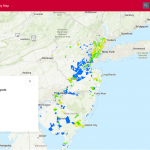New Jersey Future Blog
Christie’s Red Tape panel deserves praise for recommending a shakeup of N.J. planning process
May 3rd, 2010 by Jay Corbalis
The following op-ed by NJ Future Executive Director Peter Kasabach was published in the Asbury Park Press, the Bergen Record, the Trenton Times and New Jersey Newsroom recently:
Gov. Chris Christie’s Red Tape Review Group made headlines last week with a report that catalogued many of the often redundant, sometimes conflicting and occasionally ludicrous rules and regulations promulgated by state agencies. Grabbing particular attention were such oddities as the ban on discount milk coupons, the “exotic animal” fee for farmers who raise more than 10 bison and the continuous monitoring and hourly logging of apartment boilers.
But one significant recommendation that slipped below the radar screen deserves especially high praise. The report calls for a major shakeup in the way the state coordinates development and decides where and how New Jersey grows.
“The Red Tape Review Group recognizes that the Office of Smart Growth and the State Planning Commission need to be strengthened,” the report concludes. “A transfer of their functions to the Department of State could serve to reinvigorate the planning functions of State Government, and ensure that planning activities complement job creation and retention, economic growth and investment.”
While some may view the state planning function as another layer of bureaucracy that impedes economic growth, it is telling that the Red Tape Review Group, tasked with weeding out unnecessary regulation, responded with a recommendation to strengthen state planning. By providing an overall strategic vision for New Jersey, an effective state planning process can align state and local resources to promote development and redevelopment in priority growth areas, while preserving and protecting natural resource areas.
Where the state planning function is physically located is important. From 1986-1998, the State Planning Commission and Office of State Planning (as it was then known) were part of the Department of Treasury. Since being transferred to the Department of Community Affairs, the commission and the office (renamed the Office of Smart Growth in 2002) have steadily lost their influence and effectiveness. Subordinated to a department whose land-use activities should be subject to the commission’s oversight, rather than vice-versa, the commission and office have been marginalized – too often functioning not as a mediator but as a contestant in bureaucratic battles between competing state agencies.
The Red Tape Review Group heard from many sources that a revitalized state planning process could play an important role in improving the efficiency of state government. “In fact, there was considerable support for the idea that a new State Plan for the 21st century must be developed that sets up key principles, and State agency rules and master plans must be coordinated with this overall State Plan,” the panel reported. “Witnesses proposed that state planning should be used as a tool to align all levels of government behind a shared vision for future growth and preservation, as well as a means to streamline and coordinate regulations and focus capital spending.”
Transferring the State Planning Commission and Office of Smart Growth to the Department of State, under the Lieutenant Governor, would elevate them to heightened roles, strengthening the state planning function. Focusing their attention on directing growth and preservation in accordance with the State Development and Redevelopment Plan would return them to their primary objective. And giving them the tools they need to coordinate the planning functions of key state agencies – notably the departments of Environmental Protection, Transportation, Community Affairs and Agriculture – around the shared vision of the State Plan would reinvigorate the state planning process after years of stagnation and neglect.
The State Plan is a blueprint for where and how New Jersey — already the most developed state in the union — should direct economic growth, development, redevelopment and preservation in the years ahead. While it is not in itself a regulatory document, it should help guide the programs, regulations and capital spending of state agencies that affect the location, size, scope, timing and pace of growth in urban, suburban and rural areas of New Jersey. When these activities send conflicting or competing signals to the regulated community, the State Planning Commission and Office of State Planning, with the clout of the Lieutenant Governor behind them, should be the catalyst for getting state government to speak with one voice.


















Never too late to add kudos for an op-ed with long-term perspective and ongoing importance. Conclusion seconded here.